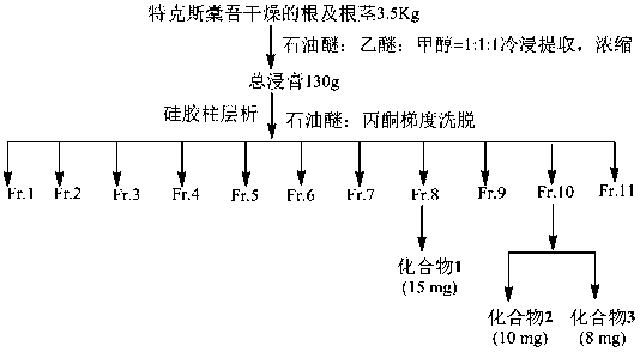Use of bisabolane type sesquiterpene compounds in preparing anti-complement drugs
A technology of bisabolane and sesquiterpenoids, applied in the field of preparation of anti-complement drugs and bisabolane-type sesquiterpenoids
- Summary
- Abstract
- Description
- Claims
- Application Information
AI Technical Summary
Problems solved by technology
Method used
Image
Examples
Embodiment 1
[0028] Example 1 Preparation of bisabolane-type sesquiterpenoids
[0029] Take 3.5 kg of dried roots and rhizomes of L. tekesi, crush them, and use petroleum ether: ether: methanol = 1:1:1 to repeatedly cold soak and extract 3 times at room temperature, soaking each time for 7 days. The solvent was recovered under reduced pressure to obtain 130 g of the total extract. 130g of total extract and 100-200 mesh silica gel 1:1 mixed sample, wet column (5 kg SiO 2 ), petroleum ether-acetone gradient elution (50:1, 30:1, 15:1, 9:1, 7:1, 5:1, 3:1, 2:1, 1:1) fractions were subjected to TLC The detection was pooled into 11 fractions (Fr.1-11). Fraction Fr.7 (2.5g), was loaded on a forward silica gel column by dry method, eluted with petroleum ether-acetone (10:1), obtained fractions, sampled, detected by TLC and concentrated sulfuric acid-vanilla The aldehyde reagent was used for color observation, and the samples were combined to obtain 3 parts, which were eluted by silica gel column...
Embodiment 2
[0030] Example 2 Anti-complement classical pathway test in vitro
[0031] Take 0.1ml of complement (guinea pig serum), add barbiturate buffer solution (BBS) to prepare a 1:5 solution, and double-dilute with BBS to 1:10, 1:20, 1:40, 1:80, 1: 160, 1:320 and 1:640 solutions; take 1:1000 hemolysin, each concentration of complement and 2% sheep red blood cell (SRBC) each 0.1ml dissolved in 0.3ml BBS, mix well, 37 ℃ water bath for 30min, then put into low temperature Centrifuge in a high-speed centrifuge at 5000rpm and 4°C for 10min, take 0.2ml of the supernatant from each tube and put it in a 96-well plate, measure its absorbance at 405nm, and set up a full hemolysis group (0.1ml of 12% SRBC dissolved in 0.5ml of three Distilled water), using the absorbance of three-distilled water lysed blood vessels as the standard of full hemolysis, calculate the hemolysis rate, take the dilution of complement as the X-axis, and the percentage of hemolysis caused by each dilution of complement a...
Embodiment 3
[0032] Example 3 Anti-complement alternative pathway test in vitro
[0033] Take 0.2ml of complement (human serum), add AP diluent (barbital buffer, pH 7.4, containing 5 mMg 2+ , 8 mMEGTA) was prepared into a 1:5 solution, and double-diluted into 1:10, 1:20, 1:40, 1:80, 1:160, 1:320 and 1:640 solutions, and each concentration was taken Complement 0.15ml, AP diluent 0.15ml and 0.5% rabbit erythrocyte (RE) 0.20ml, mix well, put in a low-temperature high-speed centrifuge at 37°C for 30 minutes, centrifuge at 5000 rpm and 4°C for 10 minutes, take Put 0.2 ml of the supernatant in each tube into a 96-well plate, and measure the absorbance at 405 nm. At the same time, a complete hemolysis group (0.20 ml 0.5% RE dissolved in 0.3 ml triple-distilled water) was set up in the experiment. The absorbance of triple-distilled water-lyzed blood vessels was used as the standard for full hemolysis. Hemolysis rate, take the dilution of complement as the X-axis, and the percentage of hemolysis c...
PUM
 Login to View More
Login to View More Abstract
Description
Claims
Application Information
 Login to View More
Login to View More - R&D
- Intellectual Property
- Life Sciences
- Materials
- Tech Scout
- Unparalleled Data Quality
- Higher Quality Content
- 60% Fewer Hallucinations
Browse by: Latest US Patents, China's latest patents, Technical Efficacy Thesaurus, Application Domain, Technology Topic, Popular Technical Reports.
© 2025 PatSnap. All rights reserved.Legal|Privacy policy|Modern Slavery Act Transparency Statement|Sitemap|About US| Contact US: help@patsnap.com



